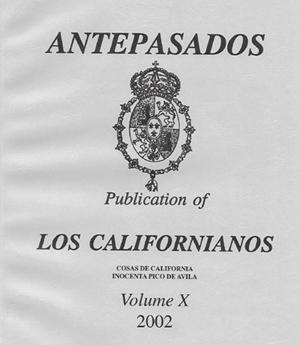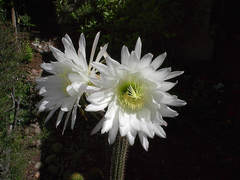
 Purpose
Purpose
As stated in Article II of the Los Californianos Bylaws, the purpose of this organization shall be:
To preserve the heritage of early Hispanic Californians in Alta California; to conduct research on genealogy and on civil, religious, military, and cultural activities in Alta California; and to provide an accurate and authentic interpretation of Alta California’s history by such means as the Board of Directors may prescribe.
Los Californianos members Linda Milleman, Joe Barnes, and Woody Milleman.
manning a booth at the SCGS Jamboree.
Position Statement
Los Californianos is a non-profit organization whose members have direct blood-line descent from the thousands of individuals of Hispanic ancestry who were residents of Alta California when it was a province of the Viceroyalty of New Spain or the Republic of Mexico between 1769 and 1848. We represent and embrace the broader diversity of ethnicities that encompass the Californio heritage, and we do so by way of promoting and facilitating genealogical research and the study of family histories, State-wide conferences, and community workshops.
Our purpose is to recognize, celebrate, preserve, and foster the promotion of a bonafide Californio history, heritage, and culture, which is foundational to the very robust economy of modern California. We stand in favor of the accurate and thoughtful depiction of individuals, groups, and key events in the history of this great State.
We support, honor, and respect the acknowledgement and inclusion of all ancestors who had a hand in building our great State, but stand against the vandalism, destruction, and other forms of cultural erasure of those monuments, buildings, symbols, and other property linked to the history and heritage of California and the Californios. These symbols of our ancestors are sacred to us, and we challenge public officials to act on their public responsibility to protect the heritage rights of all of the people of California.
In so doing, we call upon public officials to recognize our right as the documented descendants of settlers of Alta California between 1769 and 1848 to be invited to the table and included in any and all discussions regarding the removal, modification, erasure, or destruction of those historic Hispanic and Mexican heritage symbols, monuments, buildings, markers, exhibitions, names, and texts affected.
We believe that embracing the diverse histories, heritage, and cultures of California is a promise for the future. Moreover, we believe that honoring our ancestors need not come at the expense of others in a fashion that we deem divisive and counterproductive to the broader goal of preserving inclusion and honoring diversity for the peoples of California.
Respectfully,
Tracie E. Murray, President

History & Activities
Preserving the Hispanic Heritage of Alta California
History
In December 1968, a small group of descendants of Spanish Alta Californians formed Los Californianos in anticipation of the bicentennial year of the discovery of San Francisco Bay in 1769 by the expedition led by Don Gaspar de Portolá.
Alta California (‘Upper California’), also known as Nueva California (‘New California’), was a province of Spain, under Spanish Rule.
Los Californianos was created for the purpose of preserving the heritage of Alta California’s early Hispanic Californians (also called Californios or Californianos). As individuals and as an organization, we conduct research on genealogy and civil, religious, military, and cultural activities in Alta California. We strive to ensure that an accurate and authentic oral, written, and pictorial interpretation of the history of Spanish and Mexican Alta California is provided to the public, especially to our fourth-grade students who study California history as part of their curriculum.

Activities
Los Californianos annually commemorates the arrival of the Juan Bautista de Anza Expedition (1775-76) to San Francisco in June 1776. Descendants of the founding families of San Francisco will celebrate the 245thanniversary of the arrival of Spanish soldados de cuera (“leather-jacket soldiers”), men, women, and children, who made the long journey overland to San Francisco and founded El Presidio de San Francisco and Mission San Francisco de Asis (Mission Dolores). Traditionally, this outdoor celebration, open to the public, takes place at the Presidio of San Francisco at the Flagpole near the historic Officers Club. During the Roll Call of Anza expedition members Descendants commemorate their Californiano ancestors by placing a flower in a special display. Join us for music, horses, and re-enactment. Period Clothing is welcome (Soldado, Vaquero, pioneer, military). Los Californianos has been partnering with the U.S. National Park Service ( http://www.anzahistorictrail.org/visit/counties/san-francisco and https://www.presidio.gov/trails/juan-bautista-de-anza-national-historic-trail ) and the Presidio Trust (
https://www.presidio.gov/visit/presidio-visitor-guide ) . Reservations for the Los Californianos luncheon program must be made in advance.

 Publications
Publications
Each quarter we publish Noticias para Los Californianos (News for Los Californianos), a newsletter for our members. In addition to updates on our organization and announcements on our activities, we feature articles on the history and heritage of Alta California and the genealogy of our ancestors.
Periodically, we publish Antepasados (Ancestors), a longer scholarly work. To date, we have published 14 volumes. Current copies of both Noticias para Los Californianos and Antepasados are provided at no cost to our members and are also available for everyone to read in our Traveling Genealogy Library.
 Cactus from Rancho Los Peñasquitos, San Diego,
Cactus from Rancho Los Peñasquitos, San Diego,
the first Mexican land grant in San Diego County.
It may be Espostoa lanata.
Photo courtesy of George Gray
 Los Californianos
Los Californianos
Los Californianos’ logo was designed by members Nancy and John Henshall in 1971. It contains some of the elements of the coats of arms of some of the kings of Spain, notably Carlos III who was king from 1759 to 1788 when colonization of Alta California was begun.
The oval shield is quartered. In the first and third quarters are gold castles on red fields representing the Kingdom of Castilla. In the second and fourth quarters are crowned red rampant lions on silver (white) representing the Kingdom of León. At the bottom point of the shield is a red pomegranate with green leaves on a white field representing the Kingdom of Granada. In the center are three gold fleurs-de-lis on blue representing the noble Bourbon family.
The arms are surmounted by an open royal crown (as opposed to a closed imperial crown.) The gold crown has four open arches of pearls, and the whole is surrounded with the collar of the Order of the Golden Fleece. The gold collar shows eight red flames coming out from blue flint stones. Suspended at the bottom of the collar is a ram or fleece.
The lions and castles representing Castilla and León have been in the Spanish coat of arms since the marriage of Los Reyes Católicos Fernando e Ysabel in 1469 and their ascent to the throne in 1474.
The reason Fernando e Ysabel made Cristobal Colón (Columbus) wait seven years before underwriting his plan to reach the East by sailing West is because their first and primary goal as Catholic monarchs of that time was to rid Spain of the Moors and the Jews.
Muslims entered Spain from North Africa in 711. They conquered all the way north to Tours in France. There they were defeated in 732 by Charles Martel (Charles the Hammer), and driven back across the Pyrenees into Spain. The Moors were in Spain for 781 years. The Reconquista was completed on January 2, 1492 with the fall of the Kingdom of Granada. The Moorish King Boabdil surrendered to Fernando e Ysabel. He and his people were sent “in tears” back to North Africa. So, the pomegranate was added to the coat of arms in 1492.
Carlos III added the fleurs-de-lis, because he was a Boubon or Borbón as they say in Spain.
The Order of the Golden Fleece was established in 1430 by Philip the Good, Duke of Burgundy. In 1477, because there was no male heir, the Grand Mastership passed to the House of Habsburg. In 1516, it passed to the Spanish branch of the House of Habsburg. Its members have been Burgundian, Austrian, and Spanish. The order still exists today in Austria and Spain.
The Duchy of Burgundy was annexed by the French crown after the death of Charles the Bold in 1477.
